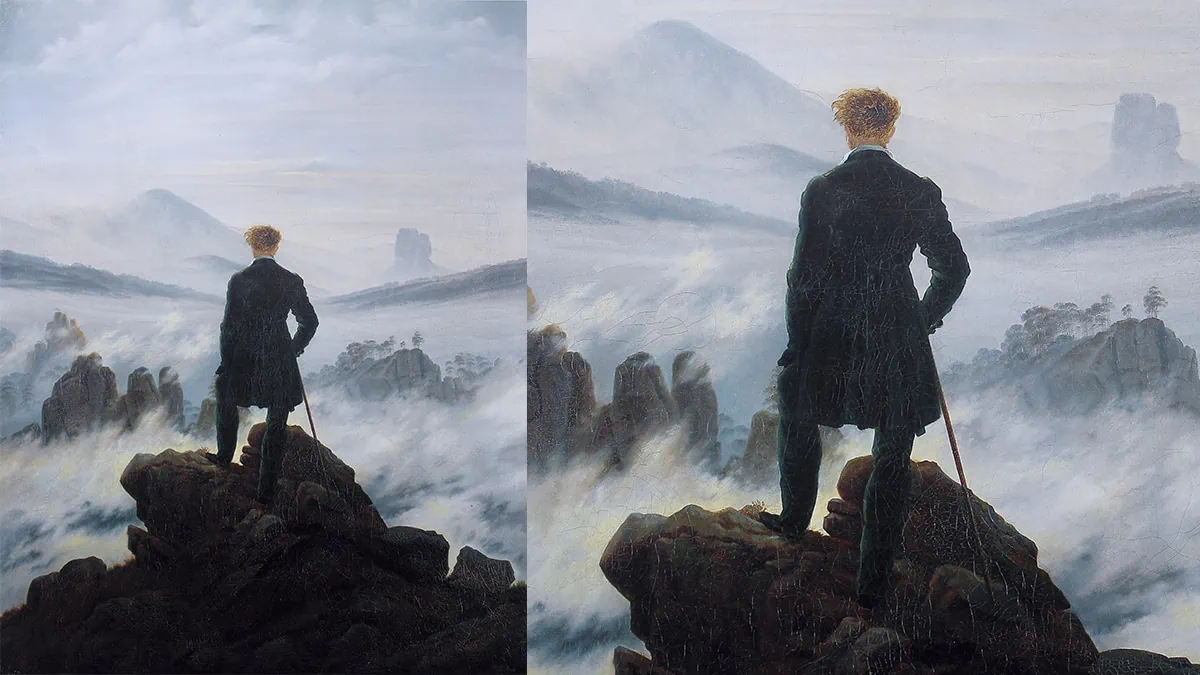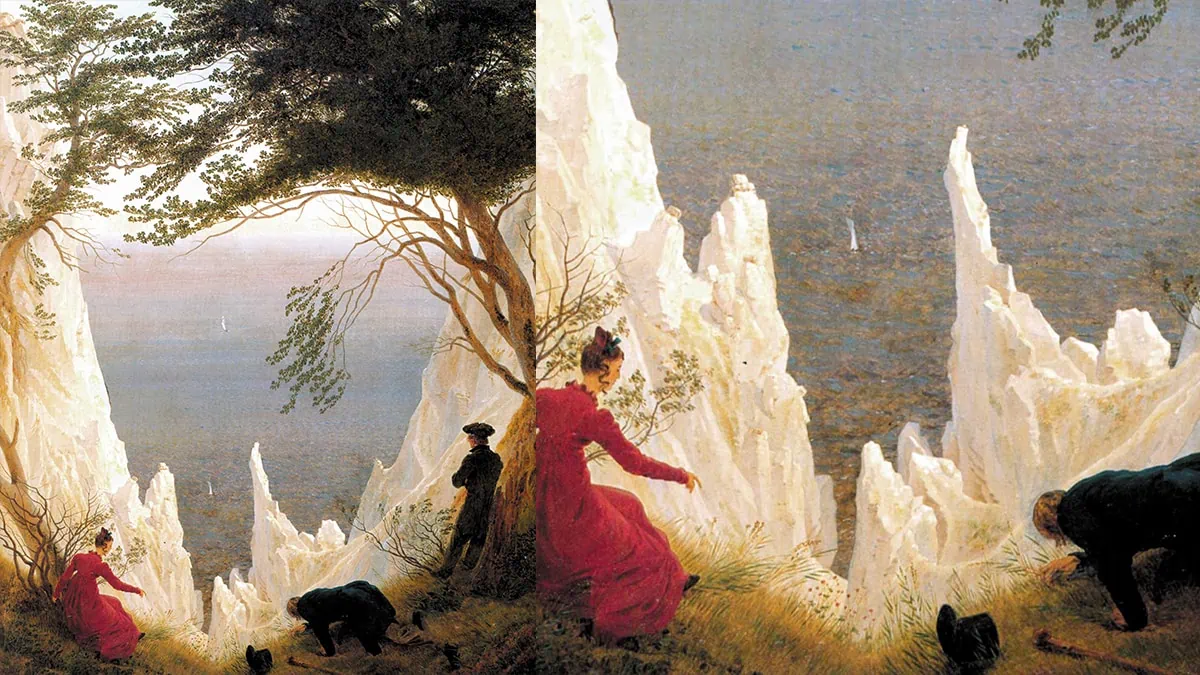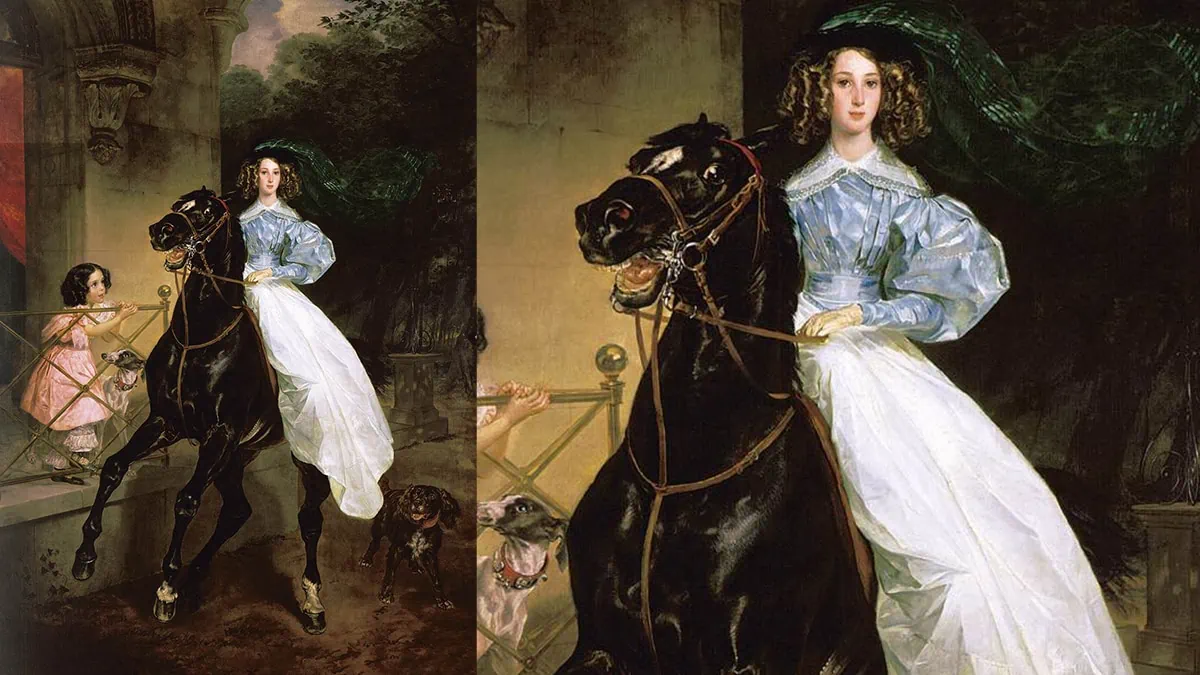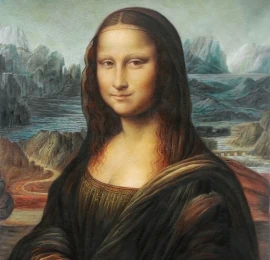Emotions, Nature, Individualism, and Beauty.
Can you tell me which period describes these characteristics?
It’s Romanticism that has given us some wonderful romantic artworks since the 1800s.
When you hear paintings of romanticism, what thoughts cross your mind?
An art that depicts love, relationships, deep affection, and intimacy?
We are used to platitudes. But that’s not quite what I have in mind.
The art of romanticism does not revolve around the theme of love but narrates nature, feelings, individuality, the beauty of humans, and other elements.
The true essence of romanticism is magnified by the self-expression and imagination of the artist.
To learn more, you can surely read about the romanticism art period, which will take you through the history of the era.
Till then, let me enlighten you with these 21 paintings of romanticism that have created their impact in one way or another.
Table of contents
- The Nightmare
- Wanderer above the Sea of Fog
- The Nude Maja and The Clothed Maja
- The Monk by the Sea
- The Third of May
- Chalk Cliffs on Rugen
- The Raft of the Medusa
- The Hay Wain
- Saturn Devouring His Son
- Salisbury Cathedral from the Bishop’s Grounds
- The Massacre at Chios
- View from the Artist’s Window
- The Death of Sardanapalus
- Liberty Leading the People
- The Rider
- Women of Algiers
- The Oxbow
- The Desperate Man
- Bridal Procession on the Hardangerfjord
- The Fighting Temeraire
- Spoliarium
- To Conclude
- To My Readers
- FAQs
The Nightmare

| Artist | Henry Fuseli |
| Created In | 1781 |
| Estimated Price | $3 to $4 Million |
| Dimensions | 1.02 m x 1.27 m |
| Housed In | Detroit Institute of Arts in the United States |
Horrified by this art that depicts one of the romanticism period paintings?
I am sure you must be.
Some unusual thoughts must have occurred after witnessing this piece, giving you the idea that such art can’t belong to paintings of romanticism.
But, it does. How?
If I tell you that this painting was produced to cope with a romantic rejection, then?
Look at the woman lying in an uncomfortable situation with the brightest light focusing on her whole figure.
It is believed that the lady in the picture is Anna, the love of Henry’s life.
After the rejection, he created a masterpiece that depicts him as the incubus and Anna as the sleeping woman.
Although a devil is sitting on her chest, with another one portrayed in the dark, the main focus is on the lady.
Henry Fuseli’s structure hinted that even the brightest source of light was powerless to penetrate the dark realms.
This classic piece of art is a mixture of horror and sexuality, which makes it a brilliant example of Gothic horror.
Also read: John William’s Romantic Art – The Soul of the Rose
Wanderer above the Sea of Fog

| Artist | Caspar David Friedrich |
| Created In | 1818 |
| Estimated Price | More than $100 million |
| Dimensions | 95 cm x 75 cm |
| Housed In | Hamburger Kunsthalle, Germany |
The title of this paintings of romanticism somehow sums up the meaning of the art that Caspar wants to convey.
The wanderer is standing with his back to the viewers on a rock facing the thick sea fog, trees, and mountains.
But what could be the exact thoughts behind creating this mindful romanticism period painting?
By placing his back to the audience, he is inviting them to see the world through his eyes and share a personal experience.
Being one of the famous artists of romanticism, it is believed that the wanderer in the art is none other than Casper himself.
Maybe it’s a self-portrait.
Well, after witnessing Wanderer above the Sea of Fog, I would surely say that this painting is romantic.
A romance with nature and their belongings made the artist share his inner thoughts with his art lover.
The Nude Maja and The Clothed Maja

| Artist | Francisco Goya |
| Created In | The Nude Maja (1797-1800), The Clothed Maja (1789-1805) |
| Estimated Price | Not Disclosed |
| Dimensions | 97 cm x 1.9 m both |
| Housed In | Prado Museum, Spain |
La Maja Desnuda (The Nude Maja) depicts a naked woman laying on a spread of pillows, which was the first nude painting portraying a female in the history of western art.
Within those five years, Francisco Goya produced another picture of romanticism, La Maja Vestida (The Clothed Maja).
The only difference we can make between the two paintings of romanticism is that one portrays a well-dressed woman, whereas the other is fully naked.
You must be wondering why Goya painted the same artwork twice, with the only difference being the undressed.
Goya, as an artist, wants to portray Maja (meaning a woman) with a strong and confident gaze who is staring right into the eyes of the viewers without any hesitation.
It was a brilliant move considering the time period in which it was produced.
The painting is unique as it makes the statement that the woman shown is neither weak nor submissive.
Instead, she is an opinionated woman who is not scared to show her proud body or pubic hair.
Interesting fact: The artwork was never made public during Goya’s lifetime as the portrayal of nude drawings was prohibited.
Suggested read: Romance In Paintings
The Monk by the Sea

| Artist | Caspar David Friedrich |
| Created In | 1810 |
| Estimated Price | Not Disclosed |
| Dimensions | 1.1 m x 1.72 m |
| Housed In | Alte Nationalgalerie, Berlin |
One of the famous landscape paintings of the romantic period is again a masterpiece by Caspar David Friedrich.
This artwork from romantic period brings Caspar’s restoration to life in the second half of the twentieth century.
Who is the man in the painting? No, he is not Caspar himself.
The man here is a monk who is enjoying his solitude by grasping nature’s beauty.
As I mentioned before, one of the main characteristics of romanticism is the living world, where artists describe nature according to their thoughts.
Friedrich highlights the loneliness of each man in the universe through this artwork.
The man who is standing without a single ray of hope is continuously facing the ocean.
I don’t know whether Caspar was obsessed with the character standing with his back to the viewers, but the emotions he wanted to convey were reached by the audience.
The painting speaks about the infinite nature and powerlessness of man.
The Third of May

| Artist | Francisco Goya |
| Created In | 1814 |
| Estimated Price | More than millions of dollars |
| Dimensions | 2.68 m x 3.47 m |
| Housed In | Prado Museum |
Here comes another fantastic work by Francisco Goya, who stunned the viewers with his thoughts.
The Third of May is one of the paintings of romanticism, also known as El Tres de Mayo de 1808 en Madrid.
He depicted actual historical events that occurred during the Peninsular War.
The execution of Spanish citizens and the brutality of the people are witnessed in this painting.
They are shown helpless with the acceptance of their defeat and the lives that have come to an end.
The picture clearly portrays the faces of the Spanish people who died for their nation.
Chalk Cliffs on Rugen

| Artist | Caspar David Friedrich |
| Created In | 1818 |
| Estimated Price | Not disclosed |
| Dimensions | 90 cm x 71 cm |
| Housed In | Kunst Museum Winterthur |
An artist who recalled the special memories of his honeymoon with his wife is what Chalk Cliff is about.
Caspar David Friedrich has perfectly captured the romantic essence of his vacation with his wife, along with the details of nature.
It captivates the viewer with its dark and bright colors.
But the focus was not just on the beauty of nature but to leave the viewers with a thought to look over the edge and learn what’s beyond.
The calmness that is seen in the sea and cliffs is contradictory to the three people who find themselves very close to the cliff’s edge.
A thoughtful work of art portrayed by a husband to preserve their graceful memory makes this one of the most renowned paintings of romanticism.
The Raft of the Medusa

| Artist | Theodore Gericault |
| Created In | 1819 |
| Estimated Price | Not Disclosed |
| Dimensions | 4.91 m x 7.16 m |
| Housed In | Louvre Museum |
Among the paintings in the Louvre Museum, The Raft of the Medusa stands in the second position.
Theodore portrayed a scene from the terrifying destruction of the French marine.
He aims to analyze the social and political system by bringing to light the tragic history, suffering, and consequences of a minimal society.
The painting is a pioneer of protest art.
To set a record during his time, Theodore chose to draw this famous art in romanticism.
Not only does it have an interesting title, but it also influences other famous artists.
The Hay Wain

| Artist | John Constable |
| Created In | 1821 |
| Estimated Price | $28 million |
| Dimensions | 1.3 m x 1.85 m |
| Housed In | The National Gallery |
Look at the painting closely.
Isn’t this the most detailed work of scenery? Or the most beautiful paintings of romanticism? Doesn’t it grab your attention at first glance?
I know it does.
Well, it is John Constable’s best artwork from the six footer series.
It portrays the appealing look of a village both in the background and in the foreground.
The horse cart in the center is the most eye-catching part of this romantic portrait.
As an admirer of nature, John represents the land, water, and family in one picture.
Being recognized as the famous romanticism paintings, they were said to be a colossal failure when displayed for the first time.
It is an emotional reaction to the crisis that was beyond John’s control and understanding.
Saturn Devouring His Son

| Artist | Francisco Goya |
| Created In | 1823 |
| Estimated Price | $7.5 million |
| Dimensions | 1.43 m x 81 cm |
| Housed In | Prado Museum |
Another prominent work by Francisco Goya is Saturn Devouring His Son.
Although the artwork is famous among paintings of romanticism, the image is equally disturbing.
The artist showcases one of the Greek mammoths in a violent and aggressive state who is feeding on his own son.
There must be a question about what made Goya paint such horrifying art, right?
Let me tell you that it reflects the artist’s mindset after witnessing the war under the Spanish Inquisition.
Goya symbolizes Spain as the son and the oppressor as Saturn.
It even falls into the “black painting” category and known among the famous scary paintings of all time.
Salisbury Cathedral from the Bishop’s Grounds

| Artist | John Constable |
| Created In | 1823 |
| Estimated Price | $2.7-$4 million |
| Dimensions | 87.6 cm × 111.8 cm |
| Housed In | Victoria and Albert Museum, London |
Have you ever seen Salisbury Cathedral?
If you have, then you must know how people get attracted to the place and the environment that it offers.
If we talk about this art, then John Constable was just an artist enticed by Salisbury Cathedral’s beauty.
He was not the first painter to produce this romanticism drawing.
The attention to detail in the art is remarkable.
But the reason this art was considered among the paintings of romanticism is because it was close to John’s heart.
In 1811, he visited Salisbury Cathedral as a guest of the Bishop and eventually became close friends with the bishop’s nephew, John Fisher.
They used to write letters to each other, sharing thoughts and concerns about life.
In 1828, when Constable’s wife died, Fisher invited him to stay at Salisbury.
It was Fisher who encouraged him to paint Salisbury Cathedral by calling it ‘the subject you can take.’
This made Constable paint his most astounding masterpiece, which could be dedicated to friendship and love for his wife.
The Massacre at Chios

| Artist | Eugene Delacroix |
| Created In | 1824 |
| Estimated Price | Not Disclosed |
| Dimensions | 4.19 m x 3.54 m |
| Housed In | Louvre Museum |
The Massacre at Chios is one of the paintings of romanticism that highlights the pain and suffering of the rebellions.
A French Neoclassical artist, Ingres, stated that this romantic period of art was a portrayal of the agony of modern art.
In response to this statement, people started calling it the ‘Massacre of the painting.’
It is an obvious move to label the painting negative, as it resembles the scenario of the Chio massacre and depicts the faces of death and people suffering.
Just like Picasso’s Guernica, Eugene has worked on a theme that uncovers the torture that people went through.
The painting received mixed reactions from the viewers.
Suggested read: 7 Post Impressionist Artists
View from the Artist’s Window

| Artist | Martinus Rorbye |
| Created In | 1825 |
| Estimated Price | Not Disclosed |
| Dimensions | 14.96 in x 11.73 in |
| Housed In | The Statens Museum |
The title somehow sums up the portrayal of the painting.
The painting is dedicated to the artist’s personal level, where he describes his feelings through a view from the window.
Just like other paintings of romanticism, this artwork has many symbolic meanings.
There is a constant longing that Martinus wants to convey through the painting.
A yearning to explore and learn about the other side of the world, or it could be the opposite.
The artist could be admiring the view before leaving the place and being in a transitional state.
There are many theories that relate to this beautiful painting.
Some believe that it’s a symbol of freedom, as the bird in the cage signifies the artist’s urge to go outside.
Whereas some believe that Rorbye is sad to be leaving the place and wants to capture the essence of the view.
It could be anything, but the best part about the art is the open window, which was a clever move by Martinus to depict during the romantic era.
Suggested read: 12 Paintings of René Magritte
The Death of Sardanapalus

| Artist | Eugene Delacroix |
| Created In | 1827 |
| Estimated Price | More than a million dollars |
| Dimensions | 3.92 m x 4.96 m |
| Housed In | Louvre Museum |
Here comes another famous romanticism paintings of the era.
After being inspired by Lord Byron’s dramatic poem, Sardanapalus (1821), Eugene created this masterpiece.
The main subject of this artwork was the devastating king Sardanapalus, which was the primary reason to place it among the controversial artworks.
The main motive to paint this artwork was to have a visual view of how the disaster was caused by the King’s deeds.
Giving it a real touch, the painting shows the hate, brutality, and power that King embodies in himself.
It was reproduced by Eugene in 1844.
Liberty Leading the People

| Artist | Eugene Delacroix |
| Created In | 1830 |
| Estimated Price | $34 million |
| Dimensions | 2.6 m x 3.25 m |
| Housed In | Louvre Museum |
One of the most renowned paintings of romanticism by Eugene Delacroix.
The artwork portrays the love for one’s own country and the voices of the people.
The lady in the painting is leading with a bare-breasted outfit, which has a symbolic meaning to liberty.
The artist portrayed the French Revolution in the form of art, which made a huge impact on the viewers.
The struggle, pain, and love for their country are clearly visible in this romantic painting.
It was believed that the woman in the painting was Marianne.
The Rider

| Artist | Karl Bryullov |
| Created In | 1832 |
| Estimated Price | Not Disclosed |
| Dimensions | 206cm × 292 cm |
| Housed In | Tretyakov Gallery, Russia |
Russian artist Karl Bryullov painted The Rider at the request of Countess Julia Pavlovna Samoilova.
The painting depicts Giovanina and Amalicia, the two Russian pupils.
What captivates the viewer is the calmness of the rider in contrast to the disturbed horse.
Karl illustrates the serenity of the rider, who is quite impassive if we look at the horse’s state.
Some people find it unnatural.
What makes it fall into romanticism art examples is the use of symbols like funny and messy.
The veil of the rider highlights the dynamic and motion throughout the painting.
Women of Algiers

| Artist | Eugene Delacroix |
| Created In | 1834 |
| Estimated Price | Not Disclosed |
| Dimensions | 180 cm by 229 cm |
| Housed In | Louvre Museum |
Another Eugene’s masterpiece that belongs to romanticism era painting—Women of Algiers!
Why is it one of the paintings of romanticism? Because it depicts the western fantasy of a place of luxury and indulgence.
It gives us the feeling that the four women are posing for the artist, as there is no action taking place.
There is a profound sense of being dreamy, but the vibrant colors bring life to this beautiful art.
Delacroix elegantly portrays the serenity and sacredness of the outside world by keeping the European fantasy, which is far from reality.
Do you see the smoking pot that is placed between the women, which depicts leisure?
This shows that the art was ahead of its time.
Amazing work by Eugene!
The Oxbow

| Artist | Thomas Cole |
| Created In | 1836 |
| Estimated Price | Not Disclosed |
| Dimensions | 130.8 cm × 193 cm |
| Housed In | Metropolitan Museum of Art |
The Oxbow is a powerful landscape painting by Thomas Cole.
Thomas was believed to have been inspired by the image of the landscape in Basil Hall.
When you look at the famous romanticism portraits, there is a westward expansion.
The left side depicts untamed wildness, whereas the right side shows the growth of civilization.
The artist has beautifully put forward the concepts of development and uncultivated parts in the same picture.
We can even review the painting as having a meaning that reveals the common problem of rich people getting richer and poor people getting poorer.
This is my perspective after learning about the thought process of the artist behind the artwork.
The Desperate Man

| Artist | Gustave Courbet |
| Created In | 1845 |
| Estimated Price | Not Disclosed |
| Dimensions | 45 cm × 54 cm |
| Housed In | Private collection of the Conseil Investissement Art BNP Paribas |
Who doesn’t know The Desperate Man, the most famous romanticism painting by Gustave Courbet?
Courbet’s art collection features some famous realism paintings, and his use of the essence of realism made him a prominent artist for his new style.
The Desperate Man was said to be a self-portrait in which he shed light on the inner disturbances of an artist.
He acknowledged the painter who is struggling between his works and being recognized in the art world.
The desperate urge to be the voices of all artists.
Courbet wants to convey the ideologies that made it difficult for humankind to survive.
It could also be called romantic portraits that show the individualism of each painter’s mindset.
Suggested read: Realism Art Movement
Bridal Procession on the Hardangerfjord

| Artist | Hans Gude, Adolph Tidemand |
| Created In | 1848 |
| Estimated Price | Not Disclosed |
| Dimensions | 93 cm × 130 cm |
| Housed In | National Gallery, Oslo |
Isn’t this romanticism painting giving you a calm and peaceful energy at first glance?
The Bridal Procession on the Hardangerfjord is one of the most famous paintings painted by two Norwegians: Hans Gude and Adolph Tidemand.
As we already know, romanticism is about nature and its beauty, which is filled in this masterpiece.
The composition shown is based on the keen observation of Han Gude, who depicts the nature of various areas of Norway.
It is strongly portrayed as an aesthetic ideal that was common during the 19th century.
Each detail is an important essence in this painting. Even the boat becomes equally significant when it makes a beautiful connection with nature.
For moments like this, make a portrayal of each element. Get your boat painted with the most amazing colors added to it.
The Fighting Temeraire

| Artist | J. M. W. Turner |
| Created In | 1839 |
| Estimated Price | Not Disclosed |
| Dimensions | 90.7 cm by 121.6 cm |
| Housed In | National Gallery, London |
There is always a time when a person’s career reaches its peak.
A time where you produce any art and that becomes one of the renowned paintings.
The Fighting Temeraire is one of the paintings of romanticism that were created when J.M.W. Turner’s career was producing amazing work.
The painting may have created an unusual composition, but it won millions of hearts during its first exhibition.
Tuner painted this romanticism art in order to pay tribute to the Temeraire’s bravery.
The artist recreated the scene of the 98-gun HMS Temeraire in the most detailed manner.
The sunset is a glory of color in her honor.
It can also be a symbol that represents the end of an era with the setting of the sun.
He described the beauty of the old ship, which is contrary to the dirty tugboat, as an amazing move.
Spoliarium

| Artist | Juan Luna |
| Created In | 1884 |
| Estimated Price | 584 million (US$1.36 million) |
| Dimensions | 4.22 m × 7.675 m |
| Housed In | National Museum of Fine Arts, Manila |
Juan Luna’s Spolaiarium is one of the paintings of romanticism that show dying gladiators.
The message that the artist wants to convey through the art is the cruelty, injustice, and helplessness of the gladiators who are suffering.
A symbol of human social and political life is spoliarium romanticism.
The picture creates an insatiable scene that usually takes place in a Roman circus.
If we talk about why Juan Luna painted Spoliarium, then there are no answers attached to this.
It is just a fact that he intended to submit it for the Madrid Exposition of Fine Arts in 1884.
The painting works as an ironic symbol where the gladiators are treated as slaves.
Suggested read: 13 Artists of Mexico
To Conclude
We got to know about the 21 paintings of romanticism that explain each characteristic according to the artist’s mindset.
The paintings, somehow or other, have inspired people with their different thoughts and meanings.
Maybe one of the paintings must have inspired you to some extent.
Why not get your hands on that romantic masterpiece and have your walls narrate a story?
To My Readers
First of all, thank you for reading my blog, “21 Paintings of Romanticism.”
I hope you fall for one of the paintings histories or why the artist painted in the first place.
If you have any suggestions regarding the same, please write us in the comments section, where I can read your valuable feedback.
You can also follow our Instagram page and subscribe to our YouTube channel, where we regularly update new content.
I’ll be back with another piece of writing soon. Till then, keep reading!
FAQs
Romanticism in paintings means to express an interest in the natural world, human psychology, and personal interests. Romanticism was used in the 19th century.
Romanticism focuses on emotions, and moods of all kinds, including individuality, spirituality, imagination, and mystery.
The answer may include many artists, but the top three romantic painters are: Eugene Delacroix, Caspar David Friedrich, and Francisco Goya, who gave a new meaning to the romantic period.
Antoine-Jean Gros is known as the father of romantic period artists.
The Raft of the Medusa is said to be the best-known painting of the romantic period.






